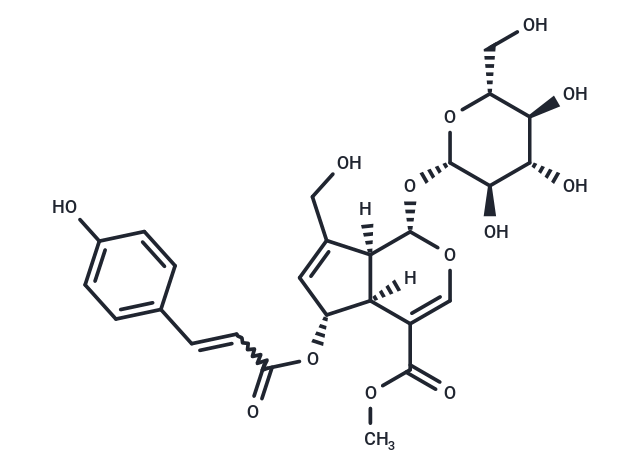Shopping Cart
Remove All Your shopping cart is currently empty
Your shopping cart is currently empty
(E)-6-O-p-Coumaroyl scandoside methyl ester is a natural product discovered in Oldenlandia diffusa suitable for biochemical experiments and drug synthesis research.

| Pack Size | Price | USA Warehouse | Global Warehouse | Quantity |
|---|---|---|---|---|
| 1 mg | $237 | - | In Stock | |
| 5 mg | $592 | - | In Stock | |
| 10 mg | $845 | - | In Stock | |
| 25 mg | $1,280 | - | In Stock | |
| 50 mg | $1,730 | - | In Stock |
| Description | (E)-6-O-p-Coumaroyl scandoside methyl ester is a natural product discovered in Oldenlandia diffusa suitable for biochemical experiments and drug synthesis research. |
| In vitro | Baihuasheshecao (Hedyotis diffusa), a Chinese herb for cancer treatment, is frequently adulterated by a related species Hedyotis corymbosa. Chemical analyses by TLC and HPLC were used to authenticate H. diffusa and H. corymbosa. Two marker compounds were identified exclusively in H. diffusa: (E)-6-O-p-Coumaroyl scandoside methyl ester and 10(S)-hydroxypheophytin a. Both compounds showed moderate anti-proliferation effect on PC3 human androgen-independent prostate cancer cells, while 10(S)-hydroxypheophytin a also showed strong anti-proliferation effect on LNCaP human androgen-sensitive prostate cancer cells. Accordingly, these bioactive marker compounds could be applied to verify the authenticity and assess the quality of Baihuasheshecao.[1] |
| Synonyms | 6-O-E-pcoumaroyl scandoside methyl ester, (E)-6-O-(p-coumaroyl)scandoside methyl ester |
| Molecular Weight | 550.51 |
| Formula | C26H30O13 |
| Cas No. | 83946-90-1 |
| Smiles | [H][C@]12[C@H](O[C@@H]3O[C@H](CO)[C@@H](O)[C@H](O)[C@H]3O)OC=C(C(=O)OC)[C@@]1([H])[C@H](OC(=O)C=Cc1ccc(O)cc1)C=C2CO |w:28.29,c:40,t:17| |
| Relative Density. | 1.56 g/cm3 (Predicted) |
| Color | White |
| Appearance | Solid |
| Storage | keep away from moisture,keep away from direct sunlight | Powder: -20°C for 3 years | In solvent: -80°C for 1 year | Shipping with blue ice/Shipping at ambient temperature. |
| Size | Quantity | Unit Price | Amount | Operation |
|---|

Copyright © 2015-2025 TargetMol Chemicals Inc. All Rights Reserved.